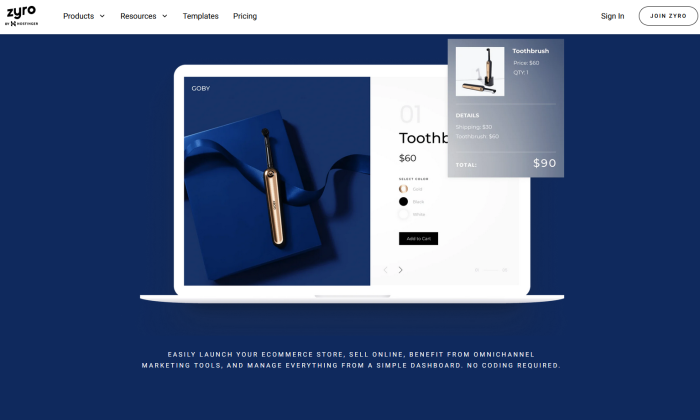How To Drive More Sales: The Ultimate Multichannel Ecommerce Marketing Guide
Learn how to make your ecommerce business gain visibility across channels, especially when you’re managing an extensive product catalog. The post How To Drive More Sales: The Ultimate Multichannel Ecommerce Marketing Guide appeared first on Search Engine Journal.

This post was sponsored by Channable. The opinions expressed in this article are the sponsor’s own.
The nature of ecommerce marketing has grown increasingly complex.
Gone are the days when you could rely solely on a single channel to drive sales for your business.
Now, in order to seamlessly integrate into consumers’ daily digital experiences, you must embrace a strategic approach that spans multiple channels.
But multichannel marketing comes with a unique set of challenges:
Optimization: Product data must be optimized and updated to meet the needs of various sellers like Google, Amazon, etc. User Experience: Customer shopping experiences should be unified and consistent across each marketplace. Perfect Campaigns: Hyper-targeted, data-driven advertising campaigns are needed to drive traffic, clicks, and sales.So, how can your ecommerce business be omnipresent across channels, especially if you’re managing an extensive product catalog?
How can you scale your efforts when faced with rising demands and limited resources?
Easy: streamline your product data process and cut your manual, low-effort tasks by 50%.
Through automation, you can:
Bring your products to market faster. Optimize your data with greater reliability and efficiency.In this comprehensive guide, we’ll walk you through some of the strategies, tactics, and tools you need to master multichannel marketing for your ecommerce brand.
Let’s explore four key ways you can improve product discoverability, run smarter ad campaigns, and amplify your online presence:
Feed Management. Marketplace Integration. PPC Optimization. Insights & Analytics.1. Optimize & Organize All Your Product Data
The key to making sure all of your products are visible is to make sure your feed is optimized.
Your goal here is to make sure your products stand out enough to captivate the right audience and get them to convert.
Successful ecommerce merchants focus on feed management and product categorization to optimize and organize their products for multiple sales channels – and you should, too.
What Is Feed Management?
Feed management is the process of filtering, enriching, and optimizing product data to sell products on multiple platforms in a seamless way.
What Is Product Categorization?
Product categorization, also known as product taxonomy, is organizing products into specific, hierarchical categories.
Basically, this is similar to creating virtual aisles for your online customers to shop in.
Having solid product categories makes it easier and faster for potential customers to find what they’re looking for.
It can also skyrocket your search engine rankings by allowing Google to crawl your site and index pages faster.
Easier navigation for consumers and Google bots means an increase of up to 35% more sales for you.
How To Optimize & Organize Your Product Data For More Sales
Time Required: Varies significantly for each marketplace
Learn: Start by learning the rules and requirements for each individual marketplace. Each marketplace has different rules and requirements for how your product feed should appear. Centralize: Then, instead of creating dozens of different XML, CSV, or text files, create a central hub of information that can easily feed into all of your potential marketplace platforms. Optimize: Focus on making sure that every piece of required product data, such as GTINs, product availability, optimized product descriptions, etc. is included in your centralized product feed. Then, make sure products are placed in their most intuitive product categories for each channel. Connect: Finally, begin the process of selecting and connecting all of your marketplace platforms to that centralized document.If you don’t have the bandwidth to manually import all of your data sources into a single product feed, automation can help.
The Easy Way: How To Automate Feed Management
If your business has thousands of products, your true first task is to speed up your inventory management process.
Use Smart Categorization to categorize millions of products instantly with ecommerce AI. Automatically merge all of your product feeds and connect to multiple channels with one click.By merging multiple data sources into one powerful feed, you can start:
Bringing products to market faster and growing your sales in a sustainable way. Boosting visibility across top-performing channels and reaching your target audience where they are. Optimizing your inventory to get the most out of each channel and better identify top performers. Taking your business to the next level by automating low-impact work and focusing on what matters most.2. Choose The Key Digital Marketplaces That Will Grow Your Revenue
The best way to maximize product discoverability for your business is to position your products where they can be easily found.
Where are your customers shopping? Amazon? Etsy?
You need to be there, too.
How To Configure A Product Feed For Online Marketplaces
Time Required To Upload: Varies significantly for each marketplace
Each marketplace is different and has different product requirements for your product feed.
Repeat these steps for each marketplace you want your products to sell on:
Create: Follow your chosen marketplace’s process to create a seller account. Some marketplaces, such as Amazon, require you to have an initial personal account before you’re allowed to create a business or seller account. Verify: Follow the process of verifying your business’ legal existence, tax information, shipping policies, and privacy policies. Discover: Learn the required, optional, and custom product data figures, as well as recommended file types or data transfer methods (XML feed file, API connection, or automated third-party provider). Configure: Set up your XML file or database, depending on which marketplace you’re connecting to, in accordance with their requirements. Google Merchant Center allows you to connect your products to their marketplace by an API or product feed, so select your preferred method, and plan accordingly. Map Product Categories: Each marketplace has different product taxonomies, so be sure you map each individual product to the correct version of your chosen marketplace’s categories. For example, you may store candleholders under “Home Decor > Shelf Decor,” however, Google and your users will expect it to be placed under “Home & Garden > Decor > Home Fragrance Accessories > Candle Holders.” Upload: Connect to or manually upload your completed document to your selected marketplace. Validate: Each marketplace will need to process and provide insight or repair instructions to make sure your products will display properly. Check For Orders: Manually check for orders placed on each marketplace and enter them into your point of sale (POS) system or shopper database. Repeat: Repeat these steps for each individual e-commerce marketplace your audience shops on.The Easy Way: Upload Products To All Marketplaces In Minutes
Time Required To Upload: 20 Minutes
Use Channable to:
Automatically list your products on multiple marketplaces in minutes, not hours. Ensure your feed will be accepted by easy marketplace by quickly seeing the errors and requirements for the feeds. Cut your product feed research time down by having everything in one place. Use fine-tuned controls to adjust your listings and even filter certain products you don’t want to advertise. Fully synchronize all marketplace orders and manage everything from one place.3. Engage Your Audience With Optimized, Impactful PPC Ads
At this point, you’ve got your expanded ecommerce business all set up and ready to go.
Your marketplace presence is diverse and your products are all categorized appropriately.
However, on some marketplaces, like Amazon, your products may never be seen without ads.
So, it’s time to get some ads running to help boost brand awareness and generate more product clicks.
The goal here is to be able to configure, launch, and customize your campaigns, all from your product feed – and you want to do it as quickly and efficiently as possible.
If you’ve used the easy way, you’ll be able to use Channable’s PPC Optimization to:
Generate your campaigns in no time. Simply generate a Search, Display, and Shopping campaign structure from one place, and keep it automatically updated based on your product feed. Create targeted ads for all your products. Creating hyper-relevant ads can often be challenging, especially when your product offering is large and you want to highlight all your items. Combine static with dynamic data from your product feed to make your ads more relevant than ever. Increase engagement with different ad formats. Automatically create a highly customized campaign structure consisting of RSAs, DSAs, Shopping, and PMax campaigns. Automate your keyword & URL strategy. Easily set up long-tail keywords from your feed, inserting dynamic keywords into your ads, and defining final URLs at keyword level in just a couple of clicks. Optimize ads with powerful rules. Always ensure that your copy is either included or excluded in ads. Optimize your ads automatically with Channable’s “If-Then” rules. Simply connect your data feed to campaign creation so you can take full control of your ads and enjoy real-time updates to things like sales prices, stock information, shipping costs, and more.4. Use Data Insights & Analytics To Inform Product Growth
By using data-driven intelligence and performance metrics fine-tuned to your KPIs, you can spot key trends, make more informed decisions, and boost your overall brand image.
Here’s how real-time performance data can help boost your results:
Automate product segmentation based on performance, and optimize campaign goals based on ROAS or CPS. Some tools even provide a full overview of your best and least performing products, so you can lead with data and take your business to the next level. Monitor your performance data on different levels. For instance, you can import revenue and cost data from your preferred channels over a certain date range right into a platform like Channable. This way, you can always calculate new data such as ROAS at a product level and make the right decisions. Gain actionable insights with Performance Max. Use performance data to segment your products into PMax that have different goals. Read your goals by understanding which products you need to boost in views or clicks. Integrate with Google Analytics and Google Ads to import data straight into Channable’s dashboard for performance-based optimizations. Make data-driven decisions for your digital marketing strategy, boost top sellers, or create more visibility for low-performing items.With smarter data, you can run more accurate campaigns and optimize your product listings to help customers find exactly what they need from you with ease.
Automate your ecommerce marketing with Channable to boost audience engagement, gain efficiency, and save time.
Transform Your Ecommerce Marketing Strategy With Channable
We live in a hyperconnected era, where consumer attention spans are fleeting and technology is constantly evolving.
And the only way to thrive in this fast-paced digital landscape is to establish a presence across various platforms, and reach your customers where they are, at the time they’re ready to convert.
Channable can help with that.
Through automated feed management, seamless marketplace integration, targeted PPC optimization, and smarter insights/analytics, you can unleash the full potential of multichannel ecommerce marketing.
Image Credits
Featured Image: Image by Shutterstock Used with permission.

 BigThink
BigThink 































